Prediction of the Strain Response of Poly-AlN/(100)Si Surface Acoustic Wave Resonator and Experimental Analysis
Abstract
:1. Introduction
2. Theory and Modeling
2.1. Responses of Resonant Frequency to Strain
2.2. Distribution of Kinetic Energy for AlN/Si SAWR and Its Influence on SCF of SAWR
2.3. SCF of Resonant Frequency for AlN/Si SAWR Based on Cantilever Structure
3. Experiment
4. Results and Analysis
4.1. Characterization of AlN/Si SAWR
4.2. Tested Strain Response of AlN/Si SAWR and Modification of the Model
5. Conclusions
Acknowledgments
Author Contributions
Conflicts of Interest
Abbreviations
| SAWR | surface acoustic wave resonator |
| SAW | surface acoustic wave |
| IDT | inter-digital transducer |
| SCF | strain coefficient factor |
Appendix A
| AlN | Si | Mo |
|---|---|---|
| C11 = 408.03 (GPa) | C11 = 165.63 (GPa) | C11 = 440.77 (GPa) |
| C12 = 100.18 (GPa) | C12 = 63.87 (GPa) | C12 = 172.43 (GPa) |
| C13 = 83.40 (GPa) | C44 = 79.55 (GPa) | C44 = 121.65 (GPa) |
| C33 = 384.3 (GPa) | ||
| C44 = 100.08 (GPa) | ||
| C66 = 153.93 (GPa) | ||
| C111 = −3072.30 (GPa) | C111 = −825 (GPa) | |
| C112 = −514.07 (GPa) | C112 = −451 (GPa) | |
| C113 = −75.06 (GPa) | C123 = −64 (GPa) | |
| C123 = −155.12 (GPa) | C144 = 12 (GPa) | |
| C133 = −614.88 (GPa) | C166 = −310 (GPa) | |
| C344 = −576.45 (GPa) | C456 = −64 (GPa) | |
| C144 = −150.12 (GPa) | ||
| C155 = −100.08 (GPa) | ||
| C222 = −2413.0 (GPa) | ||
| C333 = −2213.6 (GPa) | ||
| = 3260 kg/m3 | = 2329 kg/m3 | = 10,200 kg/m3 |
References
- Rodriguez-Madrid, J.G.; Iriarte, G.F.; Williams, O.A.; Calle, F. High precision pressure sensors based on SAW devices in the GHz range. Sens. Actuators A Phys. 2013, 189, 364–369. [Google Scholar] [CrossRef] [Green Version]
- Thiele, J.A.; Cunha, M.P.D. High temperature LGS SAW gas sensor. Sens. Actuators B Chem. 2006, 113, 816–822. [Google Scholar] [CrossRef]
- García-Gancedo, L.; Milne, W.I.; Luo, J.K.; Flewitt, A.J. Sensors based on SAW and FBAR technologies. In Proceedings of the 4th International Conference on Smart Materials and Nanotechnology in Engineering, International Society for Optics and Photonics, Gold Coast, Australia, 10 July 2013.
- Benetti, M.; Cannata, D.; di Pietrantonio, F.; Marchiori, C.; Persichetti, P.; Verona, E. Pressure sensor based on surface acoustic wave resonators. IEEE Sens. 2008. [Google Scholar] [CrossRef]
- Pohl, A. A review of wireless SAW sensors. IEEE Trans. Ultrason. Ferroelectr. Freq. Control 2000, 47, 317–332. [Google Scholar] [CrossRef] [PubMed]
- Hornsteiner, J.; Born, E.; Fischerauer, G.; Riha, E. Surface acoustic wave sensors for high-temperature applications. In Proceedings of the 1998 IEEE International Frequency Control Symposium, Pasadena, CA, USA, 27–29 May 1998; pp. 615–620.
- Zhang, S.; Yu, F. Piezoelectric materials for high temperature sensor. J. Am. Ceram. Soc. 2011, 10, 3153–3170. [Google Scholar] [CrossRef]
- Lin, C.M.; Yantchev, V.; Zou, J.; Chen, Y.Y.; Pisano, A.P. Micromachined one-port aluminum nitride lamb wave resonators utilizing the lowest-order symmetric mode. J. Microelectromech. Syst. 2014, 23, 78–91. [Google Scholar] [CrossRef]
- Lin, C.M.; Chen, Y.Y.; Felmetsger, V.V.; Senesky, D.G.; Pisano, A.P. AlN/3C–SiC composite plate enabling high-frequency and high-Q micromechanical resonators. Adv. Mater. 2012, 24, 2722–2727. [Google Scholar] [CrossRef] [PubMed]
- Lai, Y.J.; Li, W.C.; Lin, C.M.; Felmetsger, V.V.; Pisano, A.P. High-temperature stable piezoelectric aluminum nitride energy harvesters utilizing elastically supported diaphragms. In Proceedings of the 2013 Transducers & Eurosensors XXVII: The 17th International Conference on Solid-State Sensors, Actuators and Microsystems (Transducers & Eurosensors XXVII), Barcelona, Spain, 16–20 June 2013; pp. 2268–2271.
- Farrell, R.; Pagán, V.R.; Kabulski, A.; Kuchibhatla, S.; Harman, J.; Kasarla, K.R. High temperature annealing studies on the piezoelectric properties of thin aluminum nitride films. In MRS Online Proceeding Library; Cambridge University Press: Cambridge, UK, 2008. [Google Scholar]
- Lin, C.M.; Lien, W.C.; Felmetsger, V.V.; Hopcroft, M.A.; Senesky, D.G.; Pisano, A.P. AlN thin films grown on epitaxial 3C–SiC (100) for piezoelectric resonant devices. Appl. Phys. Lett. 2010, 97, 141907. [Google Scholar] [CrossRef]
- Bao, Z.; Hara, M.; Kuwano, H. Highly sensitive strain sensors using surface acoustic wave on aluminum nitride thin film for wireless sensor networks. In Proceedings of the 2015 Transducers—2015 18th International Conference on Solid-State Sensors, Actuators and Microsystems (Transducers), Anchorage, AK, USA, 21–25 June 2015; pp. 1239–1242.
- Hoang, T. Design and Realization of SAW Pressure Sensor Using Aluminum Nitride. Ph.D. Thesis, Universite Joseph-Fourier, Grenoble, France, 2009. [Google Scholar]
- Royer, D.; Dieulesaint, E. Rayleigh wave velocity and displacement in orthorhombic, tetragonal, hexagonal, and cubic crystals. J. Acoust. Soc. Am. 1985, 76, 1438–1444. [Google Scholar] [CrossRef]
- Littles, J.W., Jr.; Jacobs, L.J.; Zureick, A.H. The ultrasonic measurement of elastic constants of structural FRP composites. In Quantitative Nondestructive Evaluation; Springer US: New York, NY, USA, 1997; pp. 1807–1814. [Google Scholar]
- Rao, R.R.; Padmaja, A. Effective second-order elastic constants of a strained crystal using the finite strain elasticity theory. J. Appl. Phys. 1987, 62, 440–443. [Google Scholar] [CrossRef]
- Jones, S.; Menon, C.S. Nonliear elastic behavior of hexagonal silicon carbide. Phys. Status Solidi (B) 2014, 251, 1186–1191. [Google Scholar] [CrossRef]
- Pandey, D.K.; Yadav, R.R. Temperature dependent ultrasonic properties of aluminium nitride. Appl. Acoust. 2009, 70, 412–415. [Google Scholar] [CrossRef]
- Mcskimin, H.J.; Andreatch, P. Elastic moduli of silicon vs. hydrostatic pressure at 25.0 °C and −195.8 °C. J. Appl. Phys. 1964, 35, 2161–2165. [Google Scholar] [CrossRef]
- Featherston, F.H.; Neighbours, J.R. Elastic constants of tantalum, tungsten, and molybdenum. Phys. Rev. 1963, 130, 1324–1333. [Google Scholar] [CrossRef]
- Chung, G.S.; Phan, D.T. Finite element modeling of surface acoustic waves in piezoelectric thin films. J. Korean Phys. Soc. 2010, 57, 446–450. [Google Scholar]
- Akiyama, T.; Briand, D.; de Rooij, N.F. Design-dependent gauge factors of highly doped n-type 4h-sic piezoresistors. J. Micromech. Microeng. 2012, 22, 85034–85037. [Google Scholar] [CrossRef]
- Klemens, P.G. The scattering of low-frequency lattice waves by static imperfections. Proc. Phys. Soc. Sect. A 1955, 68. [Google Scholar] [CrossRef]
- Li, C.; Liu, X.; Shu, L.; Li, Y. AlN-based surface acoustic wave resonators for temperature sensing applications. Mater. Express 2015, 5, 367–370. [Google Scholar] [CrossRef]
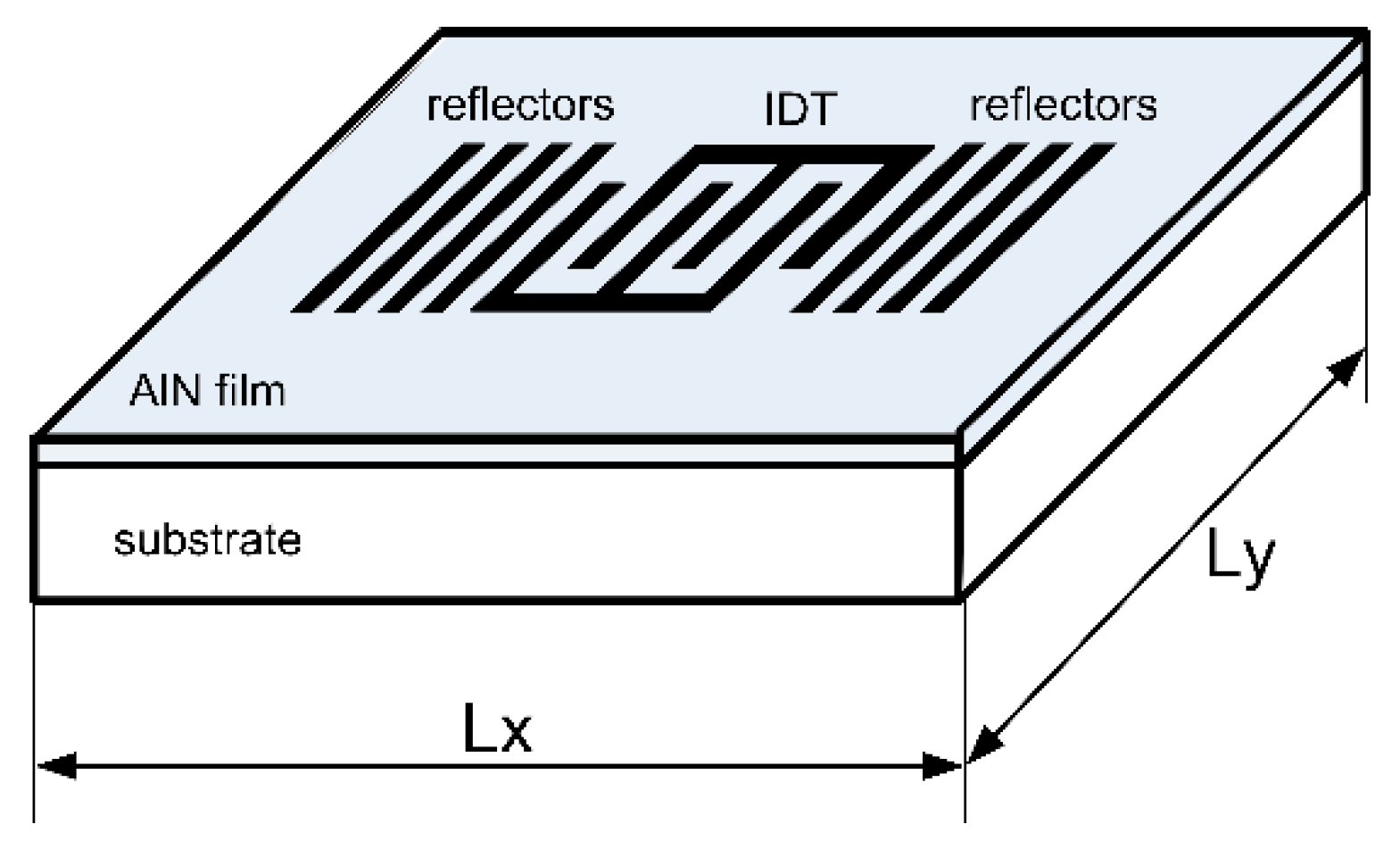


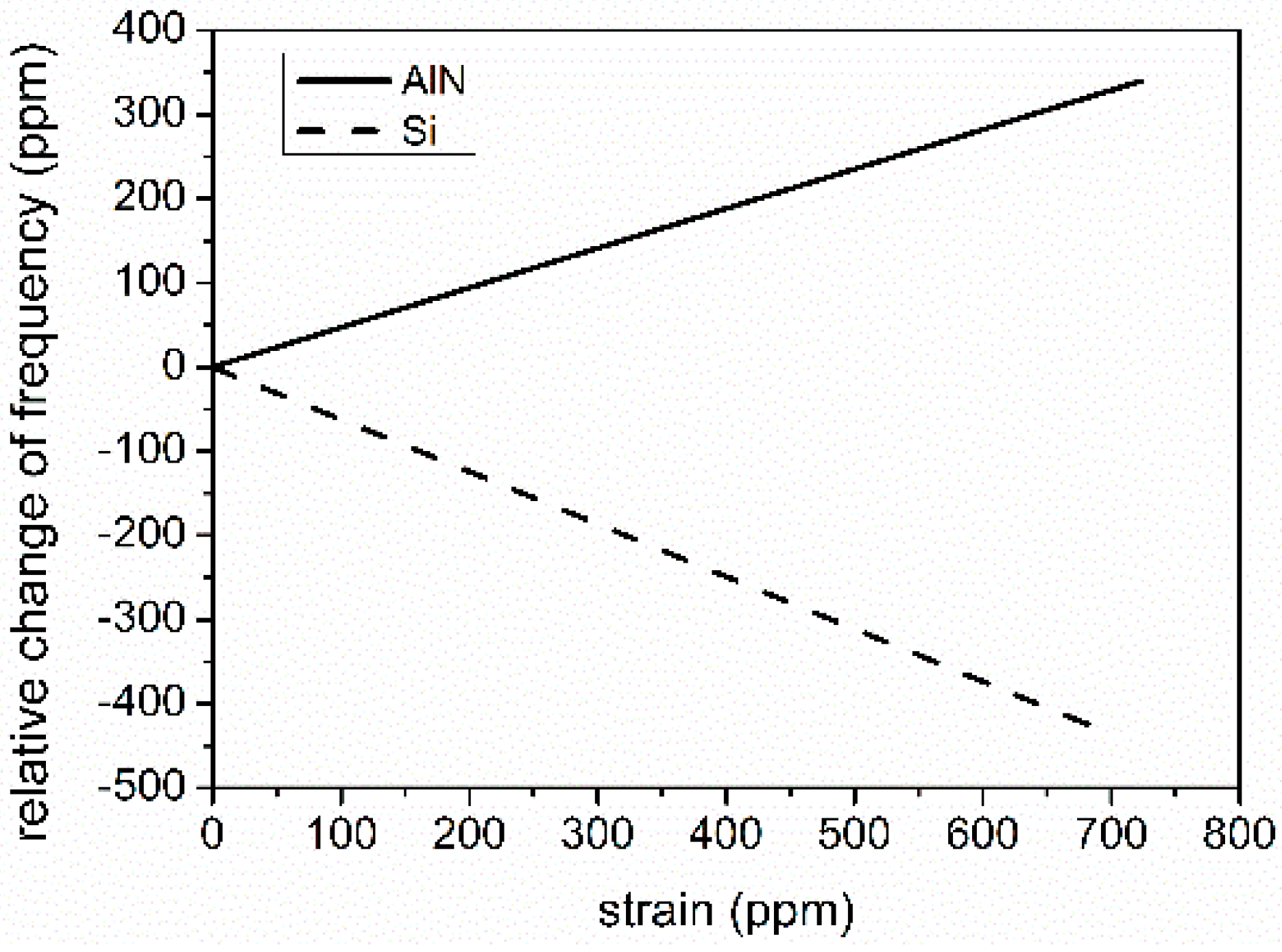
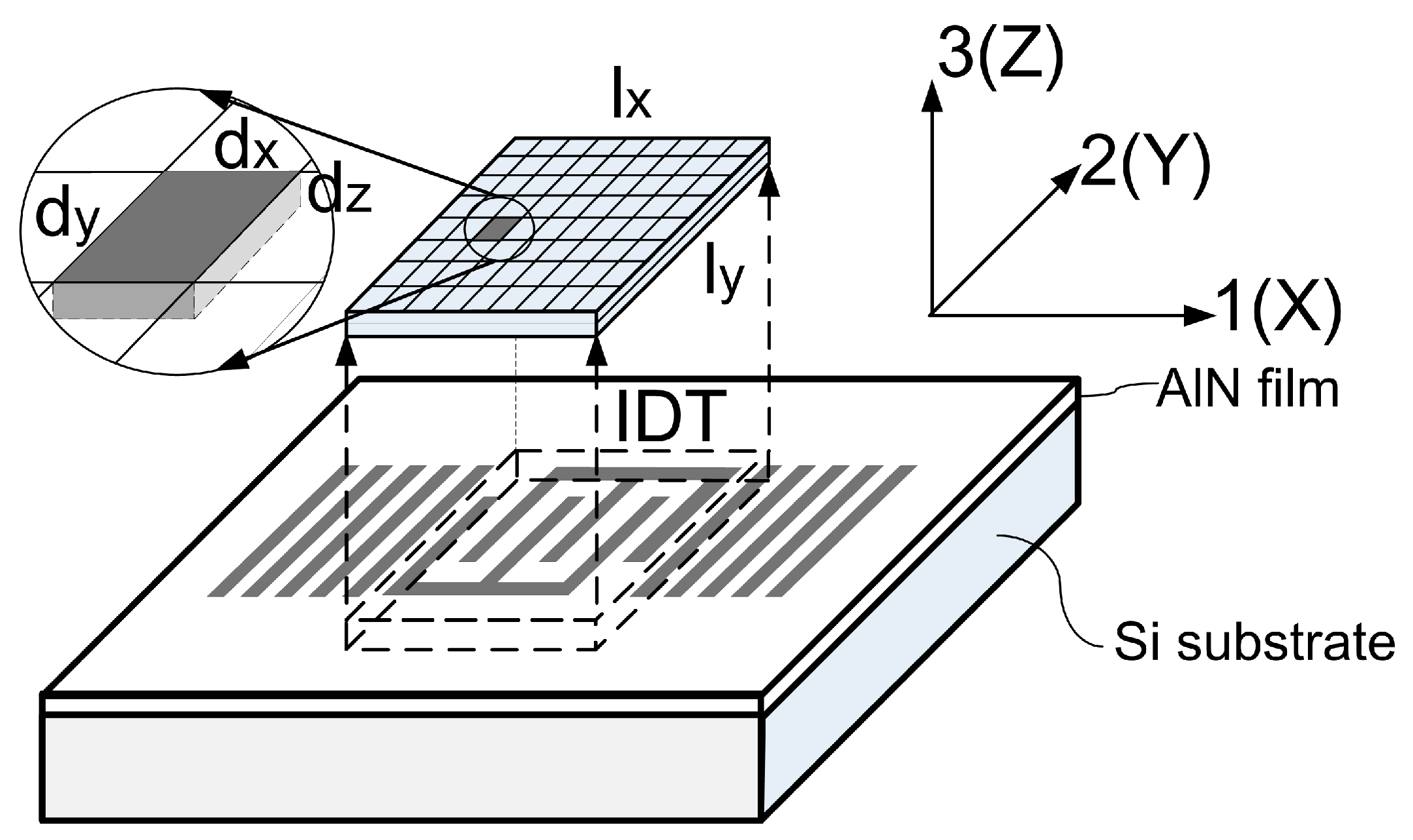
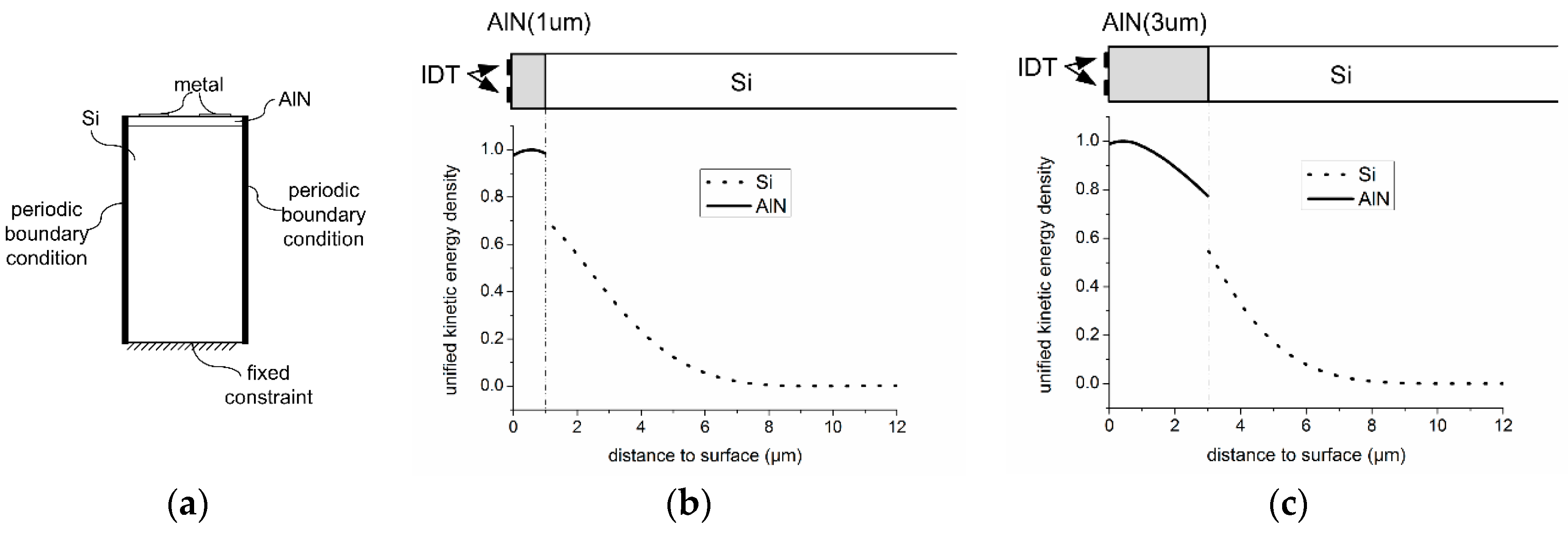
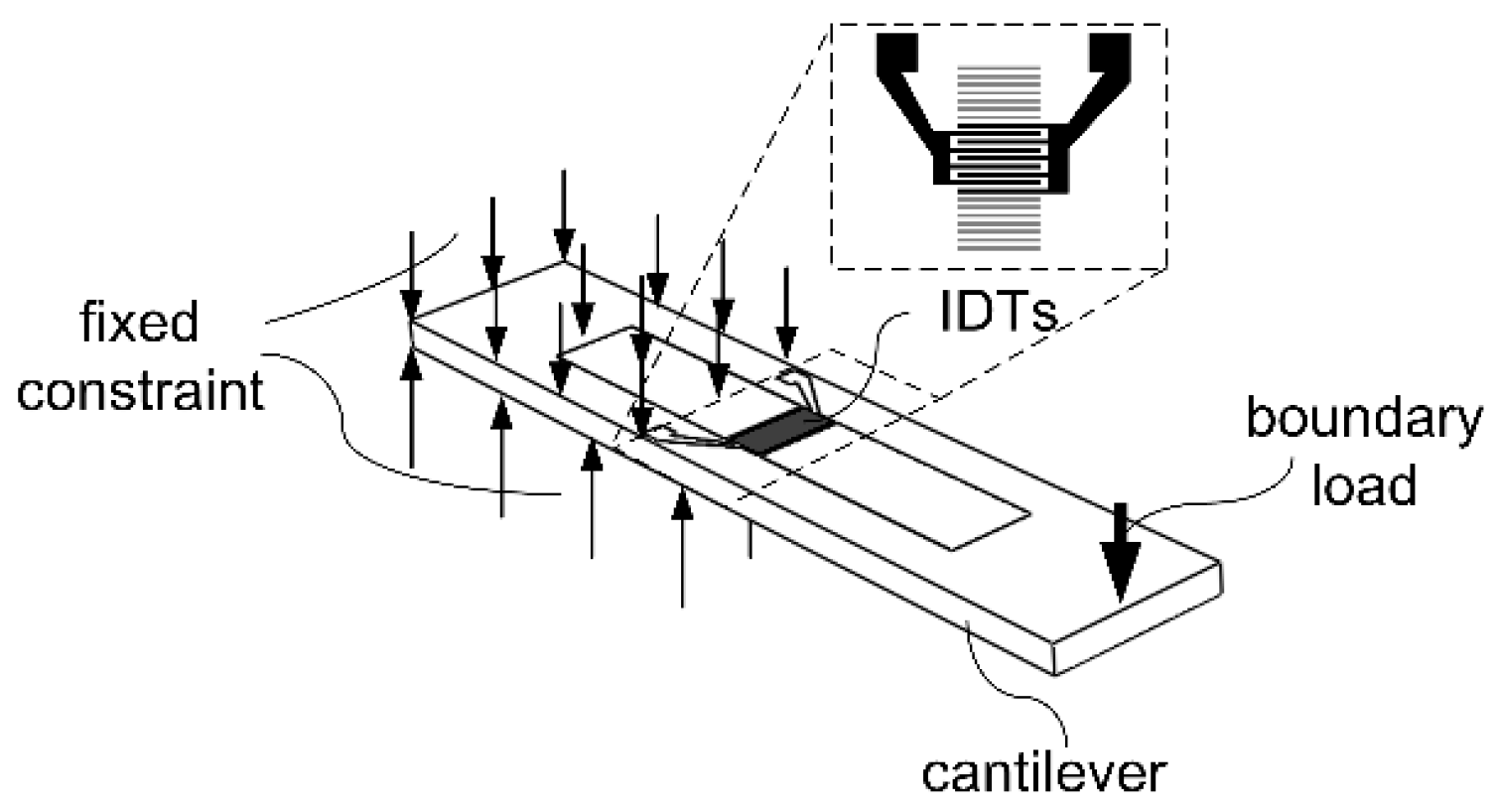
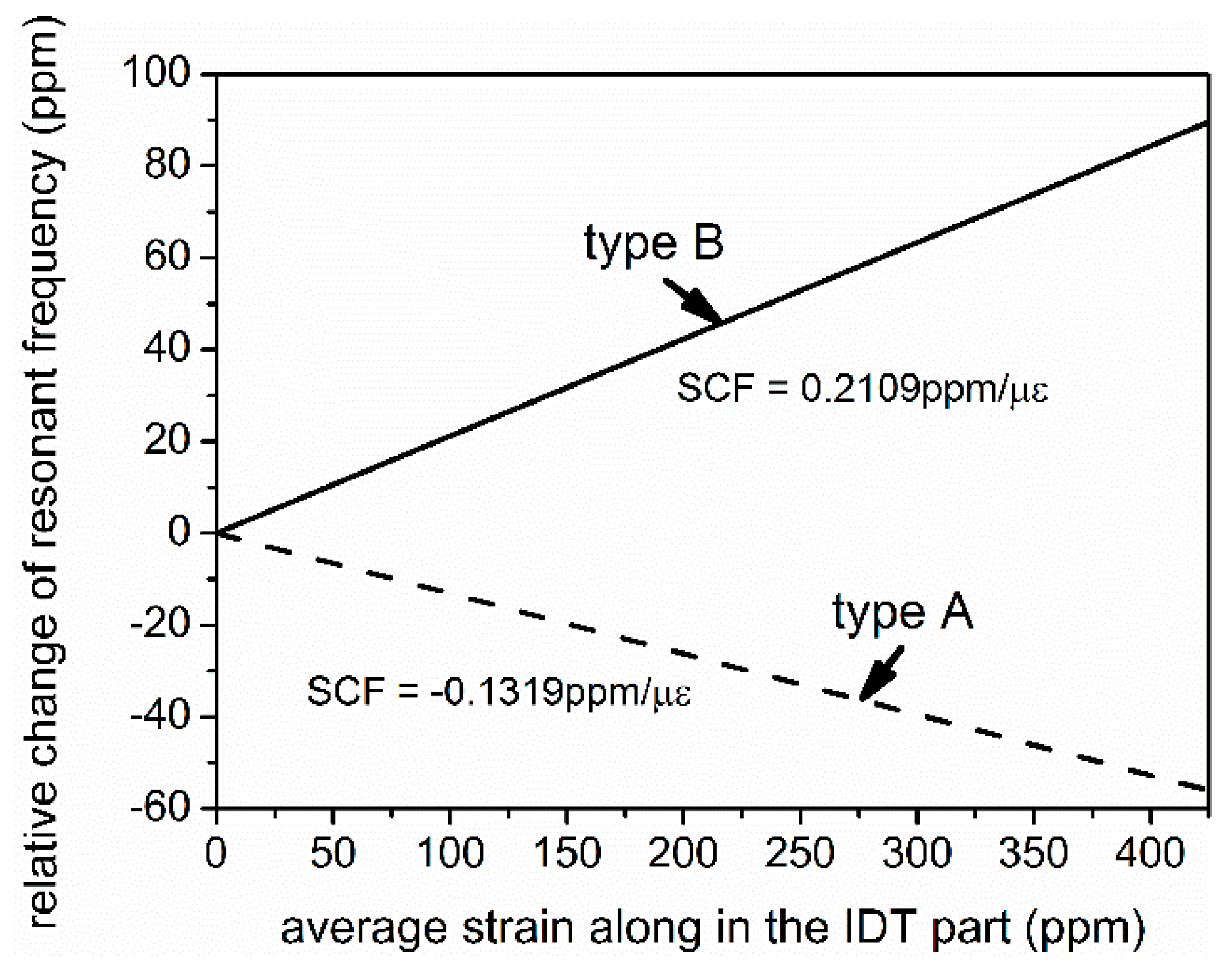

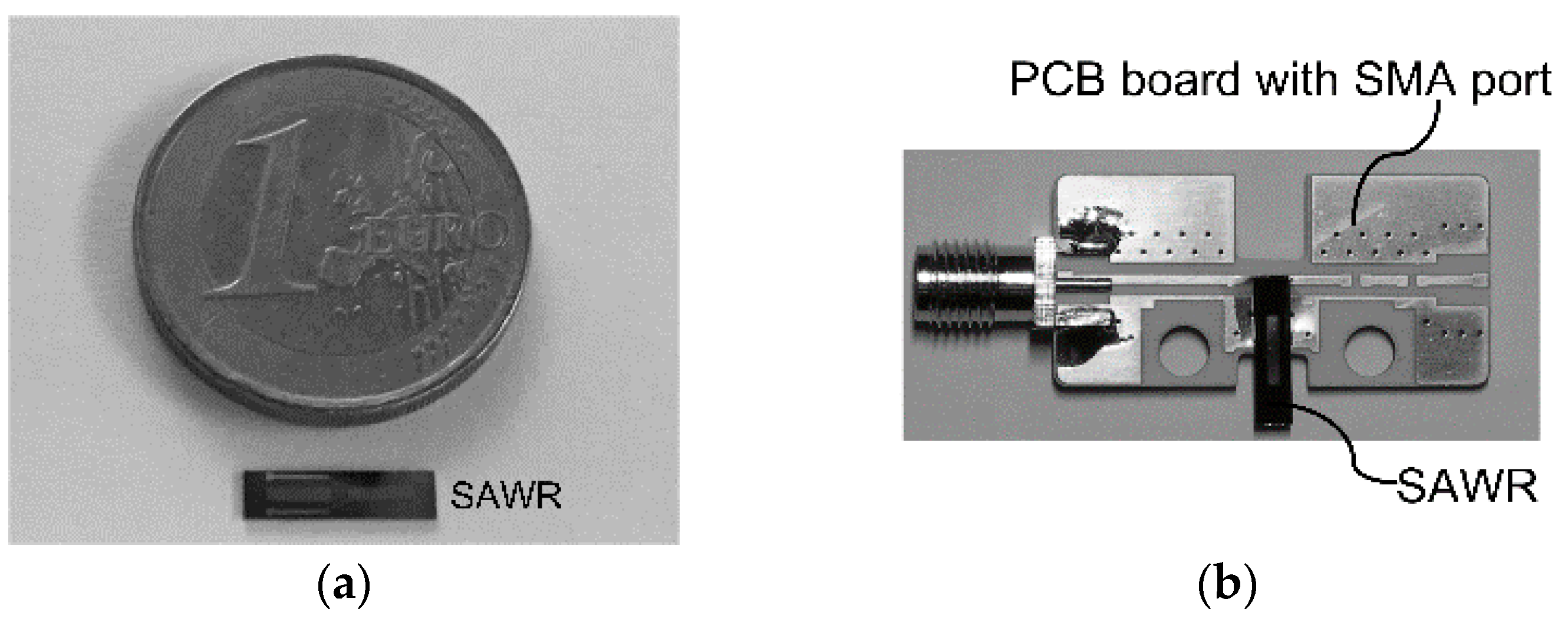
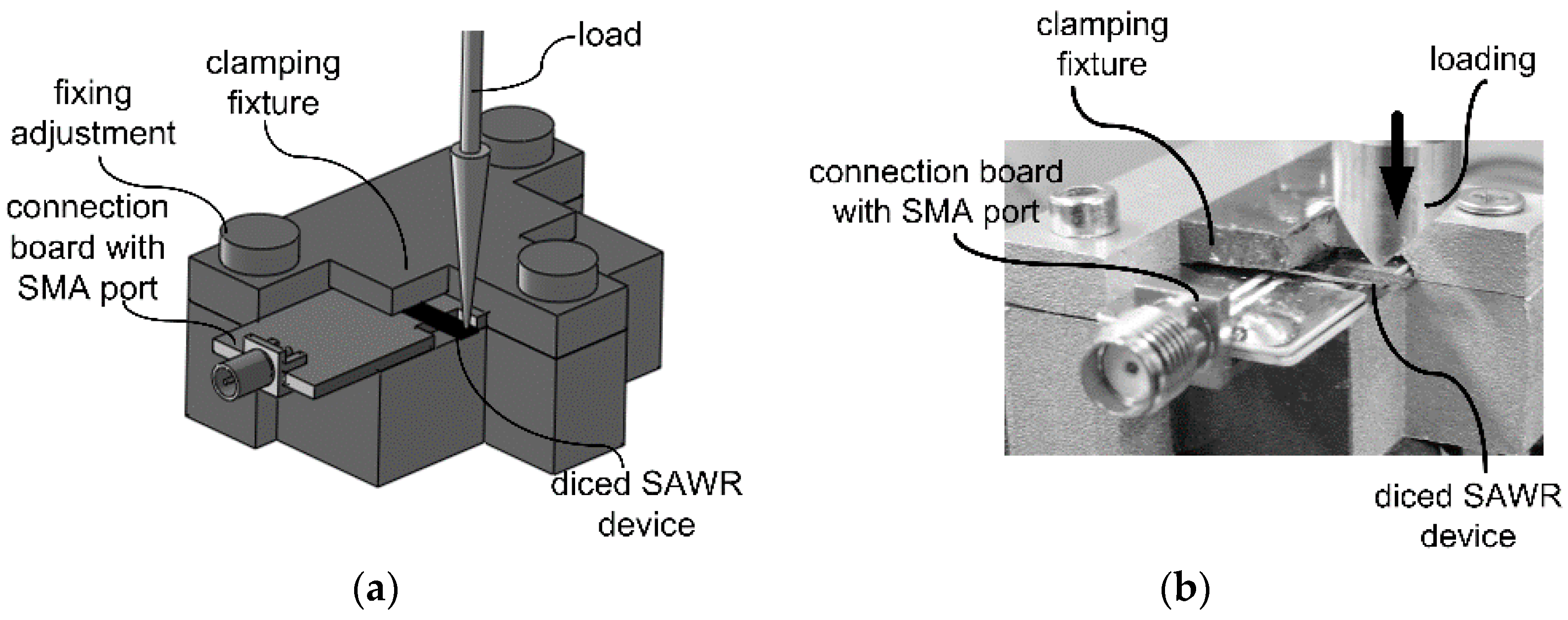
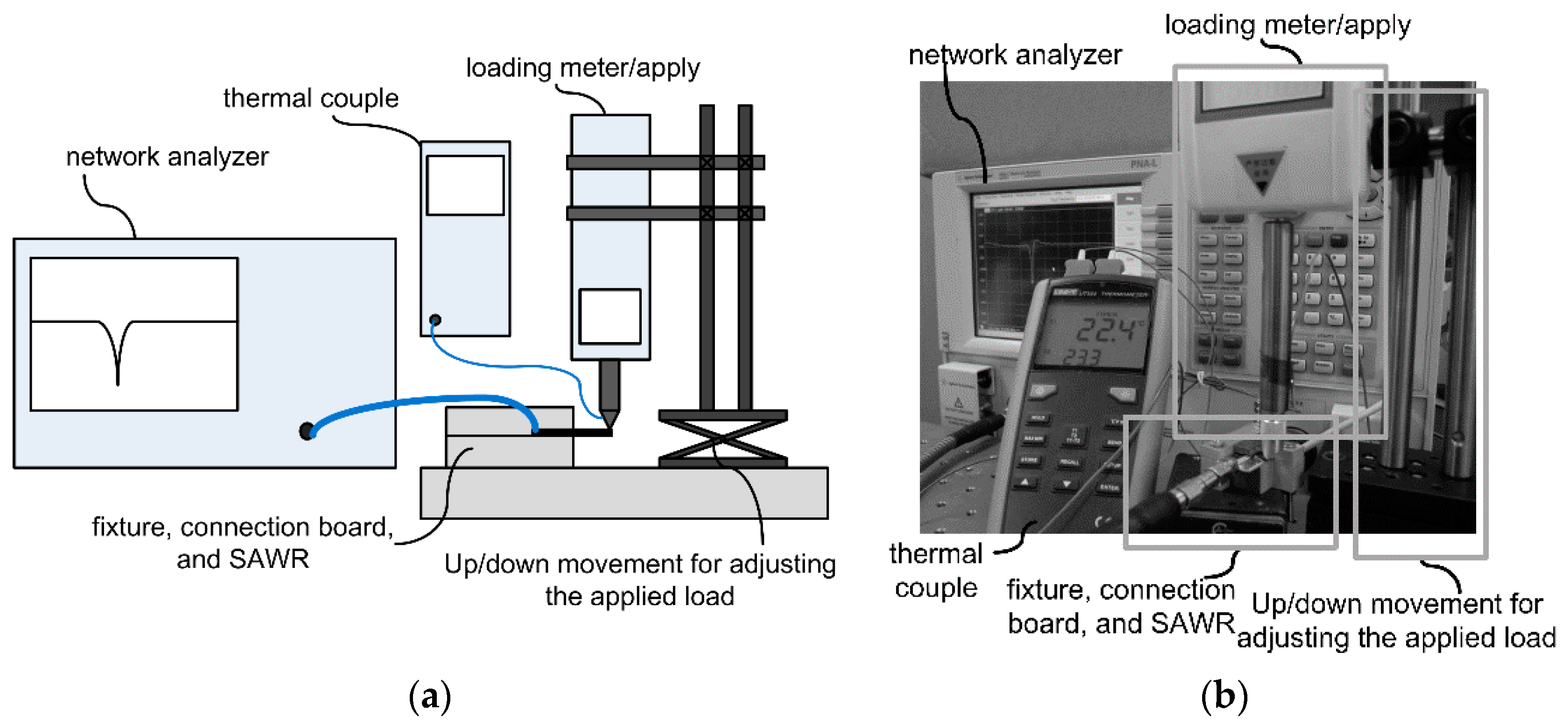
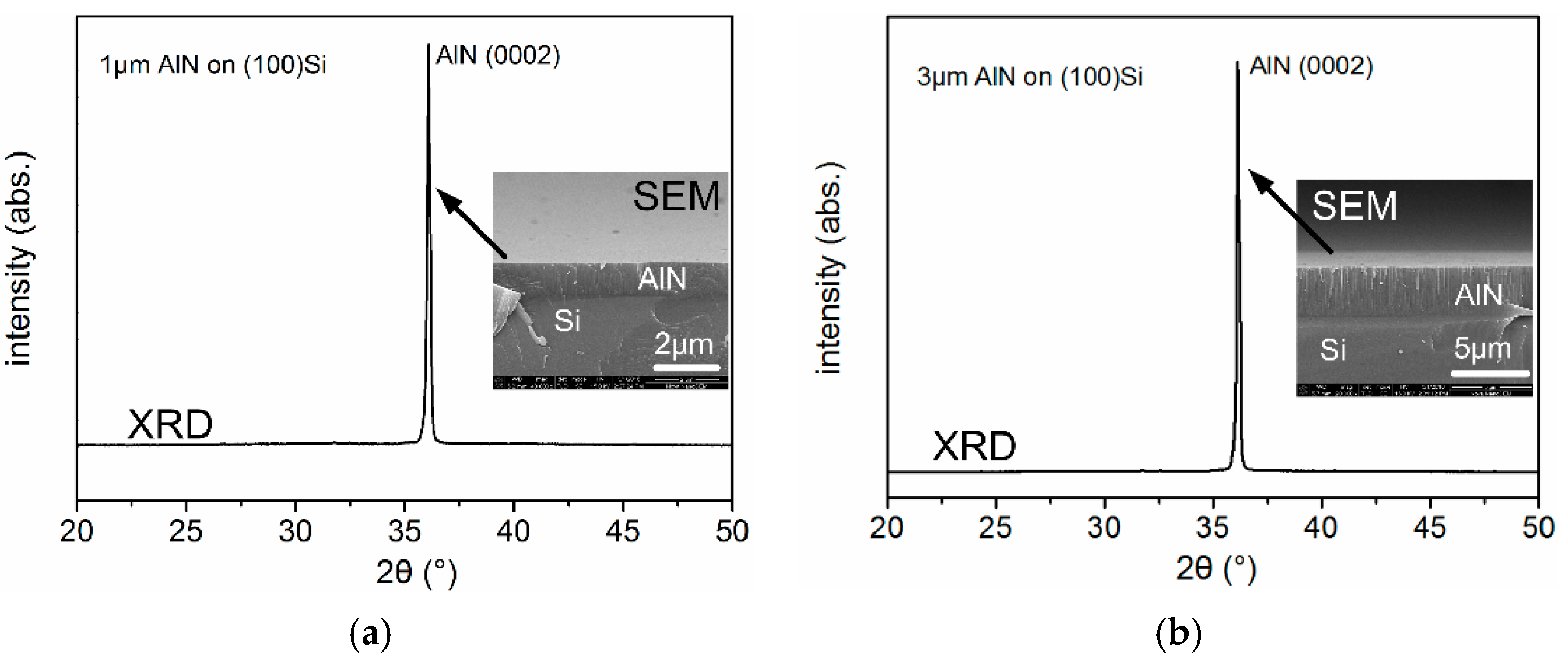
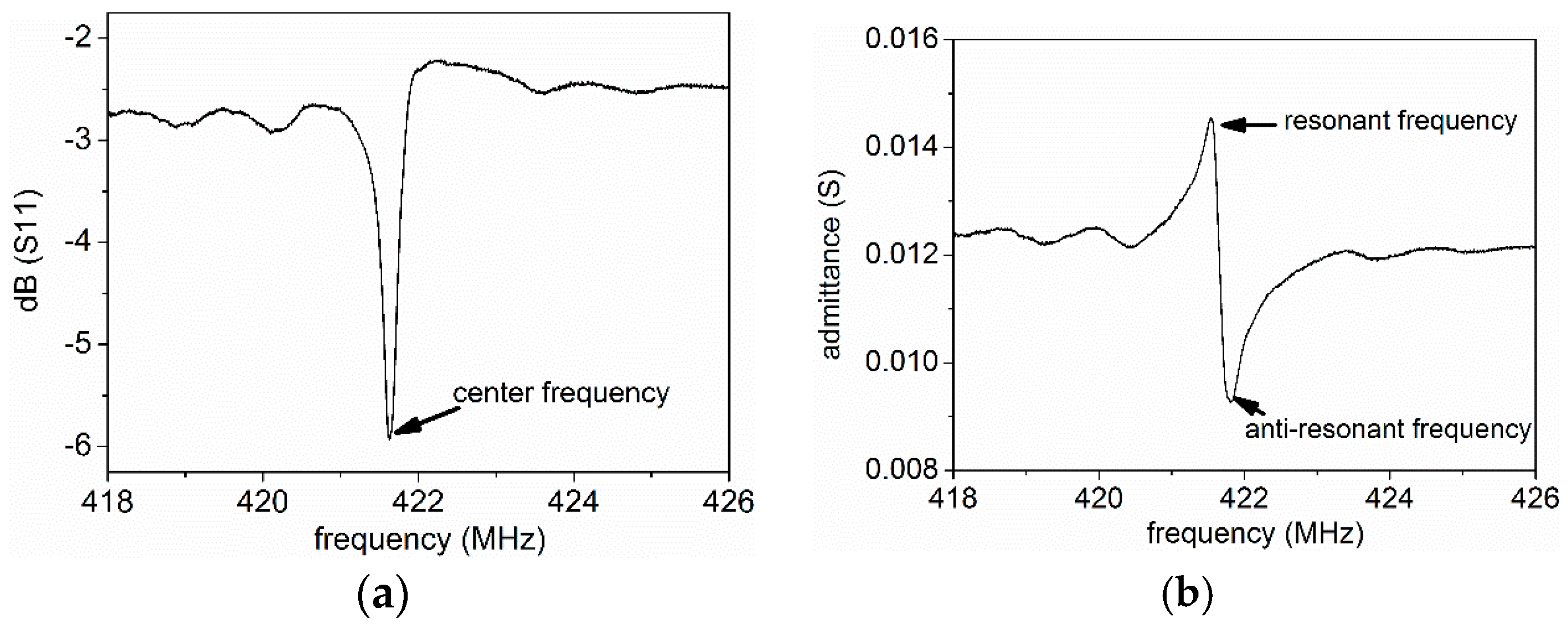
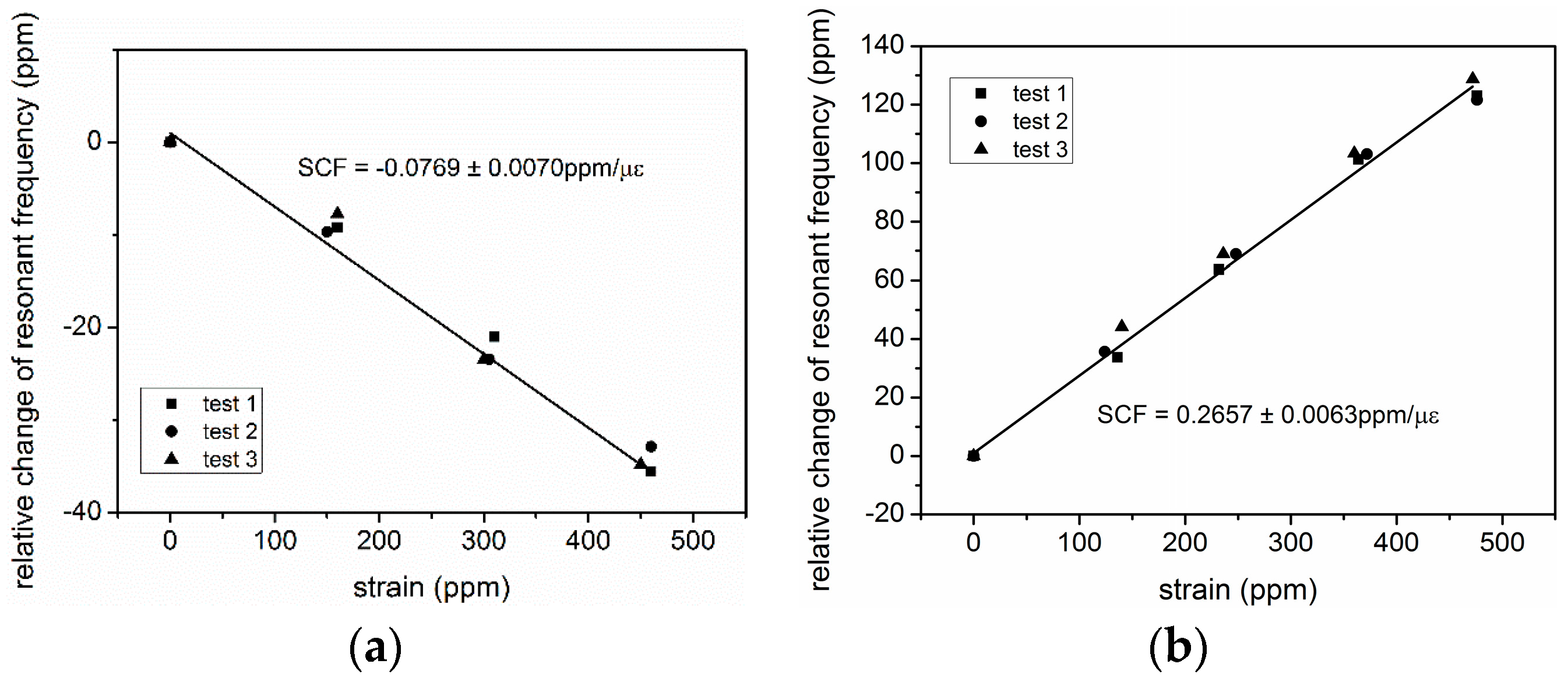
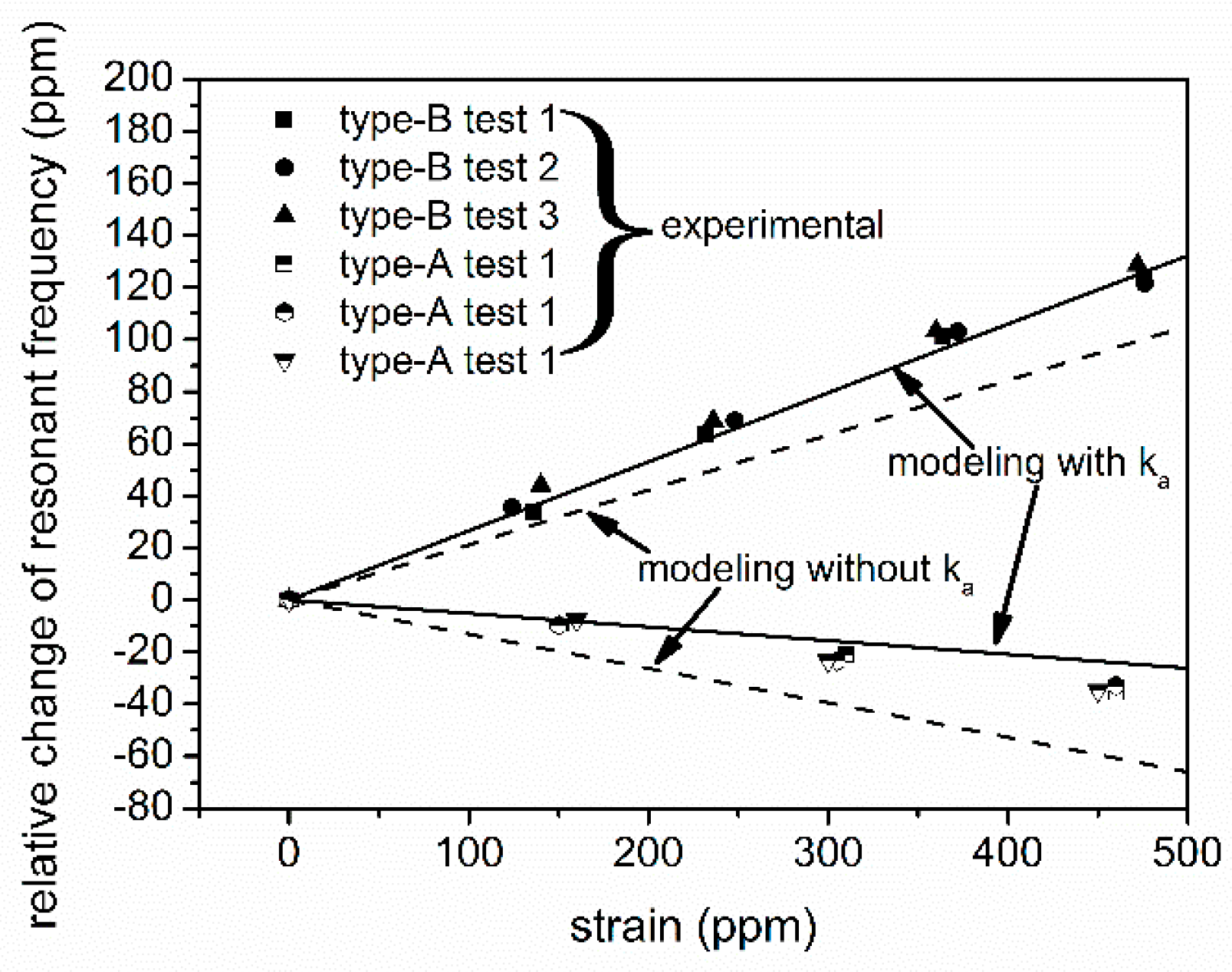
| Parameter | Value (unit) | Parameter | Value (unit) |
|---|---|---|---|
| number of IDT pairs (NIDT) | 50 | w | 1200 μm |
| 12 μm | metalizatied ratio | 0.5 | |
| equals w | |||
| 10,400 μm | 2500 μm |
© 2016 by the authors; licensee MDPI, Basel, Switzerland. This article is an open access article distributed under the terms and conditions of the Creative Commons Attribution (CC-BY) license (http://creativecommons.org/licenses/by/4.0/).
Share and Cite
Chen, S.; You, Z. Prediction of the Strain Response of Poly-AlN/(100)Si Surface Acoustic Wave Resonator and Experimental Analysis. Sensors 2016, 16, 603. https://doi.org/10.3390/s16050603
Chen S, You Z. Prediction of the Strain Response of Poly-AlN/(100)Si Surface Acoustic Wave Resonator and Experimental Analysis. Sensors. 2016; 16(5):603. https://doi.org/10.3390/s16050603
Chicago/Turabian StyleChen, Shuo, and Zheng You. 2016. "Prediction of the Strain Response of Poly-AlN/(100)Si Surface Acoustic Wave Resonator and Experimental Analysis" Sensors 16, no. 5: 603. https://doi.org/10.3390/s16050603





